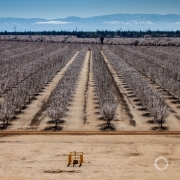Diseases of Poverty Identified in Alabama County Burdened by Poor Sanitation
Study finds “shocking” incidence of parasite infections in Lowndes County.

A red dirt road in rural Lowndes County, Alabama. Photo courtesy of Flickr/Creative Commons user thehappyrower
By Brett Walton, Circle of Blue
In the poorest sections of the American South researchers are finding hookworm, dengue fever, and other parasites and viruses that are more commonly associated with developing countries or, in the United States, with the early years of the 20th century.
The latest evidence comes from Lowndes County, Alabama, where Baylor College of Medicine researchers went on an expedition for parasitic worms. They found that two in five people who participated in a recently published health study had intestinal parasites, primarily hookworm. The parasite, once considered contained, is making a comeback in the Black Belt, a region of clay soil that stretches across nearly two dozen counties in central Alabama.
“I was shocked, quite shocked,” Rojelio Mejia, the Baylor College of Medicine researcher who guided the study, told Circle of Blue. “We thought hookworm was eradicated, or at least under control. To find such a high prevalence was concerning.”
Surprised at the results, the research team double- and triple-checked the data to verify accuracy. The peer-reviewed study was published online on September 5 in the American Journal of Tropical Medicine and Hygiene. The diseases, the researchers said, are now less a matter of political borders and more a function of economics and sanitary conditions. In this health equation, the poor suffer.
Though the study’s numbers are startling, the high incidence of parasitic infections is more understandable due to conditions on the ground, Mejia said. The central Alabama climate — warm and humid — is favorable for worms to flourish. Because hookworm is not a sensational disease like Zika or Ebola, it attracts less attention, he said. Anemia and lethargy are common symptoms, rather than birth defects or death. Perhaps most important — and most galling — is that many people live in unsanitary surroundings.
The Alabama Center for Rural Enterprise, a local nonprofit that has conducted surveys to collect data, estimates that half of the homes in Lowndes County have failing septic systems or no sanitary sewage disposal at all. According to U.S. Census Bureau data, more than one-third of households in the county are in poverty.
Many homes in the county are too scattered for a central wastewater facility, and septic systems are often a poor fit for the dense Black Belt soils, which do not drain well enough to filter waste. There are high-tech septic systems on the market, but the cost — around $10,000 to $12,000 — could consume most of a poor household’s annual income. An unknown number of homes instead connect their toilets and sinks to “straight pipes” that send the waste into gullies, creeks, or backyard pits. In these conditions, hookworm and other parasites can thrive.
More than a century ago, in 1909, John D. Rockefeller Sr. gave $1 million to establish the Rockefeller Sanitary Commission, an initiative with the goal of eradicating hookworm in the South. The commission’s work, however, lasted only five years, and hookworm continued to fester in certain areas. Infection rates in high-risk Alabama counties in the 1950s were as high as 60 percent.
Then hookworm assessments largely ceased. Health researchers stopped looking for it. Mejia said the most recent study he could find that included field research was a 1993 graduate student paper that was not published in an academic journal. The study found one to two percent of participants had hookworm in Wilcox County, a Black Belt neighbor of Lowndes.
The Wilcox study and Mejia’s study are difficult to compare. What changed is the method of investigation. Older studies assessed hookworm infections by looking at stool samples beneath a microscope. The level of magnification provided by the lens is not strong enough to detect parasites below a concentration of roughly 12 eggs per gram.
Mejia instead used DNA analysis, which is sensitive to low parasite concentrations, even below one egg per gram. Better equipment means an increase in detection, he said.
Sixty-six people, all African Americans, participated in the study, which included samples of blood, stool, and soil as well as a health questionnaire. Stool samples, taken from 55 of the participants, showed that 23 had a parasite, 19 of which were hookworm.
The number of people in the study was smaller than Mejia had hoped, largely because of the difficulty in recruiting volunteers. There is widespread mistrust within the communities of outside researchers because straight pipes are illegal. Authorities can fine residents, jail them, or even take custody of children living in such conditions.
“People are afraid,” Catherine Flowers, executive director of the Alabama Center for Rural Enterprise, told Circle of Blue. She assisted Mejia, who said that without Flowers the study would probably not have been possible.
Sanitation Failures Widespread in Alabama
No person has done more than Flowers to shine a light on sewage failures in rural Alabama. In November 2012, after reading his New York Times op-ed about tropical diseases spreading among the poor in the southern United States, Flowers sent an email to Peter Hotez, dean of the National School of Tropical Medicine at Baylor College of Medicine.
Hotez had estimated that at least 12 million Americans, mostly in the states bordering the Gulf of Mexico, were living with diseases caused by worms and bacteria commonly associated with the warm, humid countries of the tropics: afflictions such as dengue fever, Chagas disease, and parasitic infections that cause seizes.
“They are the forgotten diseases of forgotten people,” Hotez wrote in the piece, published on August 18, 2012.
Flowers, though, would not let the rest of America forget. A week after sending the email, she traveled to Atlanta to meet Hotez, who was attending the annual meeting of the American Society of Tropical Medicine and Hygiene, and explained to him the problems in Lowndes County. A year earlier she had submitted testimony to the United Nations’ independent expert on drinking water and sanitation. More recently, in June, she gave a tour to Sen. Corey Booker, a Democrat from New Jersey, who was traveling in Alabama, Mississippi, and Louisiana to learn about the links between poverty, race, health, and the environment in the South.
Failing septic systems and the use of straight pipes are not confined to Lowndes County, but the extent of the problem is largely unknown. According to Mark Elliot, a University of Alabama researcher, there have been only two rigorous, county-level studies in the United States to establish how many households have failing septic systems or straight pipe discharge. Both studies are more than a decade old.
The first, in 2000, was conducted in Madison County, North Carolina. It found 5.6 percent of homes had straight pipes. The other study, based on data from Bibb County, Alabama, in 2006, found 15 percent of homes used a straight pipe and 35 percent had failing septic systems. In Bibb County alone this discharge corresponds to more than 60,000 gallons of raw sewage per day along with billions of enteric viruses, giardia, and cryptosporidium.
A smaller survey in 2016 of 289 homes without sewer connections in Wilcox County, Alabama, found at least 60 percent with straight pipes, which Elliot called “a staggeringly high number.” Wilcox County is poorer than Bibb County, and poverty is an indicator of straight pipe use. Based on that survey, Elliot estimates that 550,000 gallons of raw sewage in the county enters the Alabama River watershed every day. That figure assumes that each person generates 100 gallons of wastewater a day through showering, toilet flushing, and washing clothes and dishes, which is likely an overestimate of the daily discharge.
Straight pipes are probably more common than thought. An Auburn University study in 2011 estimated that half of Alabama’s Black Belt is unsuitable for septic systems because of poorly drained soils.
Because of the region’s clay soils, wastewater does not readily soak into the ground. Heavy rains can then flush the sewage into creeks and rivers. Elliot tested this by sampling water from Big Prairie Creek, in Hale County, during the 2016 drought and immediately after the first big rain that fall. Water samples downstream of the town of Newbern saw a huge jump in E. coli after the rain — concentrations increased by 1,000 times compared to the drought period. In Newbern, according to best estimates, at least half of homes use a straight pipe.
Elliot does not blame the county health departments, which, he says, have no good options. The arrest, in 1999, of people in Lowndes with illegal sewage disposal provoked backlash. Besides, health departments have no handy solution to offer, he explained. “People really don’t have an option,” he told Circle of Blue.
Mejia and his colleagues hope to eliminate ignorance of the problem. With the results of the initial study now published, Mejia said that he will apply for funding for a larger investigation: a health study of several hundred, maybe even 1,000 people in the county. Then researchers can begin to map areas of greatest need.
Mejia also says there is more work to do on the connections between climate change and disease. Hookworm larvae hibernate in cold temperatures. If winters are warmer, then the window for contracting the parasite, which enters the body through the skin, opens wider.
Flowers, for her part, pins hopes on developing a low-cost wastewater treatment system that suits Black Belt soils.
“We need to deal with the places that haven’t had infrastructure that functions,” she said.
Read Circle of Blue’s award-winning series on America’s spreading septic threat.
Brett writes about agriculture, energy, infrastructure, and the politics and economics of water in the United States. He also writes the Federal Water Tap, Circle of Blue’s weekly digest of U.S. government water news. He is the winner of two Society of Environmental Journalists reporting awards, one of the top honors in American environmental journalism: first place for explanatory reporting for a series on septic system pollution in the United States(2016) and third place for beat reporting in a small market (2014). He received the Sierra Club’s Distinguished Service Award in 2018. Brett lives in Seattle, where he hikes the mountains and bakes pies. Contact Brett Walton











